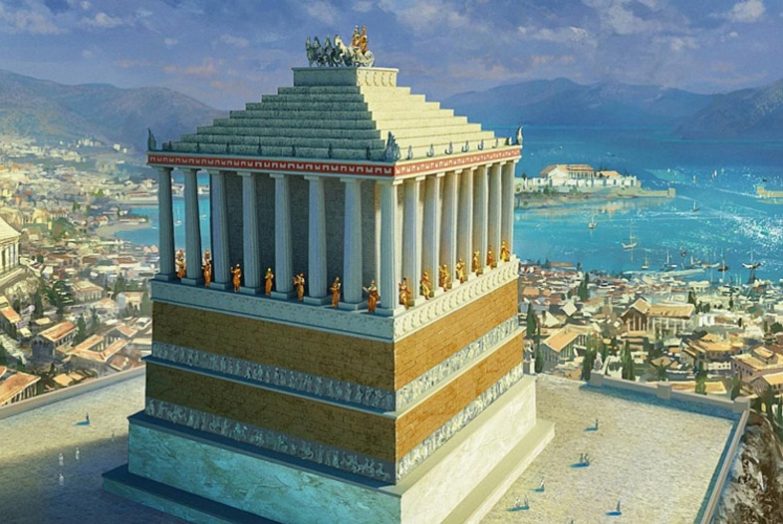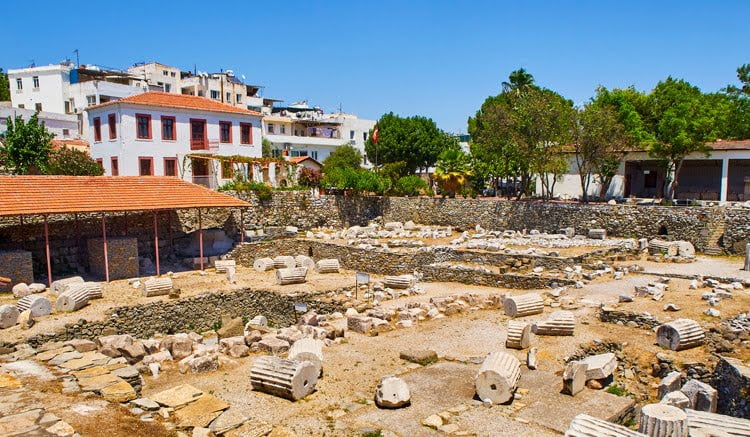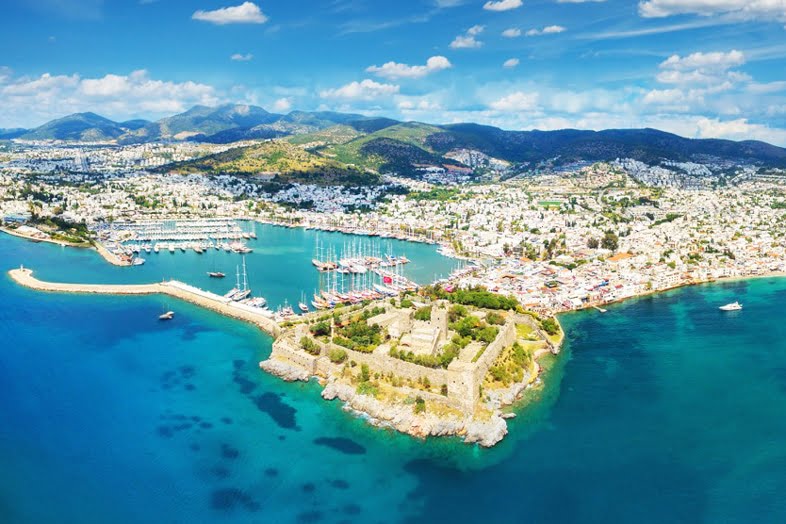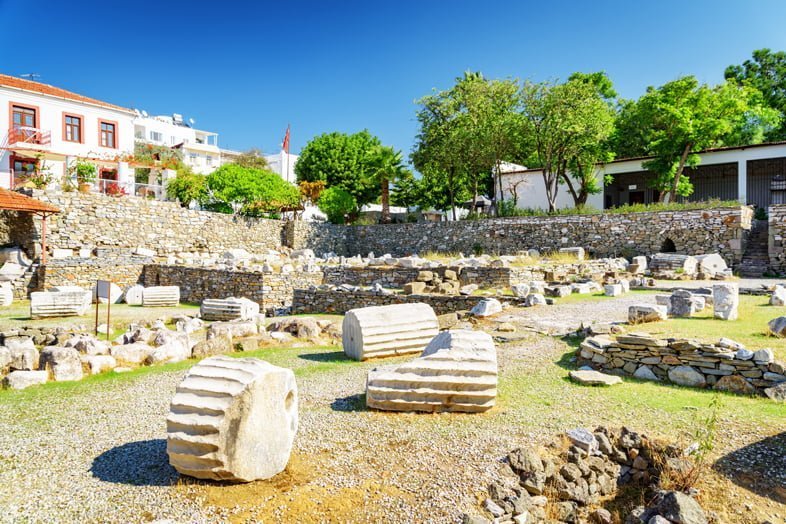
Bodrum Mausoleum of Halicarnassus
The Mausoleum of Halicarnassus, which is a significant place for Bodrum, is considered one of the Seven Wonders of the Ancient World. The mausoleum, one of the most important and magnificent architectural monuments of the period it was built, can be seen today on Turgutreis street in the centre of Bodrum as an open-air museum.
Although it does not rise in its former glory, this historical monument continues to add its soul to the city. Though most tourists who come to Bodrum overlook this important monument, an average of 20,000 people visit each year. We think this number should be higher, considering that over a million tourist visits Bodrum each year.
Before we look at the history of the Mausoleum of Halicarnassus, it is necessary to know who King Maousolos was. Because the Mausoleum was built for King Mausolos.
- Who is Mausolos?
- History of Mausoleum of Halicarnassus
- Discovery of Mausoleum of Halicarnassus
- Architecture of the Mausoleum of Halicarnassus
- Where is the Mausoleum of Halicarnassus and How to Get There?
- Entry Fee and Visiting Hours of Mausoleum of Halicarnassus
- Can the Mausoleum of Halicarnassus Come Back Home?
- Can the Mausoleum of Halicarnassus Be Rebuilt?

Who is Mausolos?
Even though Mausolos is referred as the King in most written texts, he is actually the Carian Satrap of Persia, meaning that he was never actually the King. After Anatolia came under the sovereignty of the Persian Empire, this region was divided into satraps. The modern-day meaning of the word ‘Satrap’ is ‘governor’. These satraps were officers within the central administration appointed by the King of Persia. However, there was one satrap that did not comply with this rule; the Carian satrap. Following the death of his father Hekatomnos in 377 BC, Mausolos replaced him and was the satrap of Caria between 377 – 353 BC.
Mausolos, whose name is reverently mentioned, was a ruthless but intelligent leader.
Mausolos, who took the throne after the death of his father Hekatomnos, moved to Halikarnassos (Bodrum) because of its suitability to defence and its location in the Mediterranean sea trade. Maousolos, who started a major prosperity programme, has built new cities and monuments in the Caria region and restored the region to the highest cultural and material power it has reached in its history
He managed to maintain a good relationship with the Persian kingdom at all times and ruled the region of Caria like a ‘King’. This is the reason that he is not referred to as Mausolos, but as King Mausolos. When he died in 353 BC, he was replaced by his wife II. Artemisia, who was also his sister. Domestic marriages were traditional at the time. Artemisia, who was intelligent and a warrior like her ancestors, ruled the country for two years. When she died, she was buried next to her husband in the mausoleum.

History of Mausoleum of Halicarnassus
Although most sources state that the construction of the Mausoleum of Halicarnassus began after Mausolos died, at the time of the satrapy of his wife Artemisia, it is known that it started when King Mausolos was still alive in 355 BC.
The name mausoleum is derived from the name of King Mausolos; Mausoleion. The name Mausoleion is used as a mausoleum in Turkish. All the monuments built after the mausoleum built for King Mausolos were also called a mausoleum (Mausoleion).
When King Mausolos died, his wife Artemisia continued the construction of the monument, and her siblings followed suit after her death. Although the construction of the mausoleum was decelerated in 340 BC due to the struggle between Piksodaros and Ada, it is thought that the most famous architects and sculptors of the period who worked on the mausoleum finished the construction of the mausoleum to maintain their own glory and their respect for art.
One of the last to see the mausoleum standing was Bishop Eustathios who lived in the 12th century. This indicates that the monument has survived for 1,500 years. During the great Anatolian earthquake in the 14th century, the mausoleum is thought to have been destroyed by a series of earthquakes.
This earthquake causes the biggest damage to the mausoleum!
When the Knights of St. John settle in Bodrum in 1402 and build Bodrum Castle to protect themselves from the threat of the Ottoman Empire. In 1480, Ottoman Sultan Mehmet the Conqueror is disturbed by the piracy activities of the Knights of St. John on the Eastern Mediterranean trade route. He sends the navy to Rhodes under the command of Mesih Pasha. Mesih Pasha forces Rhodes but fails to capture.
The navy also bombs Bodrum Castle, causing great damage. The Knights of St. John do not give up and use 160 thousand stones from the mausoleum of Halicarnassus, where they had previously reached the wreckage, in the reconstruction of the castle. You can find more detailed information about Bodrum Castle and its history in our article.
The second biggest damage to the mausoleum is caused by the Knights of St. John.
La Touret, one of the knights involved in the reinforcement of the castle, described the destruction of the burial monument in his diary; how they found the 12 step staircase that is now being protected by a tile roof, how they first admired the statues on both sides of the corridor leading to the burial chamber and then dismembered them.
Just when they’re going into the burial chamber, the recess trumpet rings. They return to the castle before they go into the original burial chamber. He wrote that when they returned the next day the burial chamber had been opened and that they saw precious fabrics and gold ornaments torn apart everywhere.
A large part of the Mausoleum of Halicarnassus has been destroyed, and the mausoleum, which has stood as a ruin for many years, was almost hidden by earth and vegetation.

Discovery of Mausoleum of Halicarnassus
There is probably one common name in which all natives of Bodrum and Turkish history lovers are angry with; Charles Thomas Newton. But we can add another name, Lord Stratford Canning.
Lord Stratford Canning, who the British ambassador in Turkey at the time, visits Bodrum Castle. In 1846, he asks the Ottoman Sultan for permission to take the reliefs seen on the walls of the castle to England, which are understood to belong to the mausoleum. The Ottoman Sultan Abdulmecit gives the priceless historical artefacts to Lord Stratford Canning as if he was giving away some worthless trinkets. The artefacts are taken to the British Museum in England.

The British Museum of England sends archaeologist Charles Thomas Newton and his team to Bodrum to search the Mausoleum of Halicarnassus. Newton soon finds the remains of the mausoleum. He asks permission from the Ottoman Sultan Abdulmecit to take the reliefs, statues of Mausolos and Artemisia and parts of the four horse-drawn carriages to England through Stratford Canning, the British Ambassador at the time. The Ottoman Sultan Abdulmecit, gives the priceless historical works to Charles Thomas Newton without blinking an eye. Newton, with the help of the Ottomans, takes these historical monuments to London for display at the British Museum.
We think Lord Stratford Canning and Charles Thomas Newton cause the third major damage to the mausoleum!
Newton continues taking the historical artefacts he finds during his excavations, not only in Bodrum but also in other cities, to his country. During his excavations in Datca in 1858 -1859, he finds the “Lion of Knidos” statue. This priceless artefact also greets its visitors at the main entrance to the British Museum.

Architecture of the Mausoleum of Halicarnassus
The mausoleum, whose base measures 32×38 meters, once raised in the northeast corner of a large area with a long edge of 242,5 and a short edge of 105 meters. According to the ancient authors, the mausoleum consists of four parts. At the bottom is a high pedestal (podium) with a temple-shaped section above it with 36 Ion columns, eleven on the sides and nine on the short sides; a pyramid-shaped roof with 24 steps above that and the statues of Mausolos and Artemisia in a chariot drawn by four horses at the top.
The Latin writer Plinius gives information on the height of the monument. The height of the mausoleum, which the Latins regarded as one of the Seven Wonders of the World, is 180 Ion feet, which is about 55 meters. Ancient authors write that its architect was Pytheos, who was also the architect of the Temple of Athena of Priene, also named Satyros. It is known that Skopes worked on the construction of the east side of the mausoleum while leokhares worked on the west, Bryaksis on the north and Timotheos on the south sides. Pytheos and Bryaksis are Carian artists, other artists were brought in from Greece.
The four horse-drawn carriages at the top of the mausoleum are thought to have been made by the architect Pytheos. The mausoleum raised at the site of the pit seen today, as is evident from the cut of the bedrock and the green stones.
What remains of the mausoleum is on display today as a semi-open-air museum. A model of the Mausoleum of Halicarnassus in the closed section will help you to visualize the grandeur of the mausoleum when it was still standing.

Where is the Mausoleum of Halicarnassus and How to Get There?
The Mausoleum of Halicarnassus is in the centre of Bodrum, Mugla, which is home to many significant resorts of Turkey rich in history. If you come out from the back door of Bodrum bus station and go across the traffic lights, you will reach Turgutreis Caddesi about 10 meters to your right. If you follow this street and walk about 10 minutes you’ll see the mausoleum to your left.
If you want to take a more pleasant walk from the sea side, you can walk out the front door of the bus station and walk down to the town square, walk right to the Hamam Street opposite the Tepecik mosque, turn left at the end of the street and walk 15-20 meters to the mausoleum. If you want to come from other locations in Bodrum, you can also use the city minibuses. You can get more detailed information about this topic from our Bodrum Transportation Guide article.
Entry Fee and Visiting Hours of Mausoleum of Halicarnassus
Though the Mausoleum of Halicarnassus, considered one of the Seven Wonders of the ancient world, does not rise in its historical glory, it is an essential place to visit. The place where the mausoleum raised, which is today an open-air museum, is seen as a pit.
Summer Period Visiting Hours 08:30 – 18:30
Winter Period Visiting Hours 08:30 – 17:30
Entry Fee For 2023: 70TL
Museum Card is also valid at the museum and allows two free entries per year.

Can the Mausoleum of Halicarnassus Come Back Home?
13 reliefs from the excavations of the Mausoleum of Halicarnassus, statues of King Mausolos and Artemisia, and parts of the horse-drawn chariot found at the top of the mausoleum are still on display at the British Museum in London.
The Fisherman of Halicarnassus, Cevat Sakir Kabaağaçlı was upset by the fact that the most important pieces of the mausoleum were taken to England, just as we are. He sent a letter to the Queen…
“Pieces in London are commune with the blue of Bodrum. They shouldn’t be staying in London. It’s necessary to bring them together with the blue that they are integrated into.”
Reading the letter, the Queen forwards the letter to the museum director. After a while, Fisherman of Halicarnassus, Cevat Sakir Kabaağaçlı receives a taunting reply from the director of the museum …
“We took your proposal very seriously. We had scientists examine the structure of the stones, and it’s true that they actually blend into blue. So we had the hall where the works are displayed in the museum painted in Bodrum blue. Thank you for your close attention.” Also yo might like our Fisherman of Halicarnassus atricle…
Although there were attempts to bring back these valuable historical monuments at later dates, there was no response.

Can the Mausoleum of Halicarnassus Be Rebuilt?
An exciting project was presented by the Foundation of the Academy of Mediterranean Countries in 2001. The Mausoleum of Halicarnassus has received preliminary approval from the Ministry to be rebuilt according to original in glass and aluminium construction as a Mausoleum Museum.
Foundation President, Ozay Kartal says,’Preliminary preparations continue. The project which involves the re-emergence of the Halicarnassus Mausoleum in its original location on a one-to-one scale, with light metal and glass material, is a draft project suggested by Danish Professor Kristian Jeppesen and Professor architect Johannes Exner. After taking office, our foundation introduced all the technical drawings and three-dimensional visuals. It attracted interest from both state authorities and tourism professionals in Bodrum. For this purpose, we want to put this project on the table, take the criticism and opinions of non-governmental organizations and scientists, draw the final version and restore the Mausoleum of Halicarnassus to its rightful place in the world of culture and tourism.”
We understand from our conversation with Özay Kartal that it will not be a surprise if we receive good news about the project in the coming days. We are certainly thrilled to even think that the mausoleum will rise in its former glory at its former location.
We hope that such a beautiful project will be implemented more quickly, as the huge hotel projects that have been carried out by slaughtering the nature of Bodrum are approved and implemented in a short time. We think that this project will make an impact in the world, both in terms of tourism and reflection of history to present day. If you enjoyed this article, we recommend you to read our article at Bodrum Underwater Archaeological Museum.







Add Comment